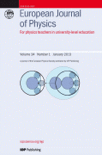
EUROPEAN JOURNAL OF PHYSICS
Scope & Guideline
Fostering Dialogue in the World of Physics
Introduction
Aims and Scopes
- Condensed Matter Physics:
This area includes studies on the structural, electronic, magnetic, and optical properties of materials, particularly those related to silicon and its compounds, nanostructures, and various doping effects. - Plasma Physics and Magnetohydrodynamics:
Research focusing on plasma behavior in various contexts, including magnetohydrodynamics (MHD), with applications in astrophysics and engineering, is a significant focus of the journal. - Optoelectronics and Photonics:
The journal covers advancements in optoelectronic materials and devices, such as solar cells and photodetectors, emphasizing their physical properties and potential applications. - Theoretical Physics and Cosmology:
Theoretical studies related to cosmological models, dark energy, and quantum mechanics are prominent, showcasing mathematical modeling and simulations. - Nanotechnology and Materials Science:
Research on nanostructured materials and their applications in various technological fields, including energy storage and conversion, is increasingly emphasized. - Computational and Mathematical Physics:
The use of computational methods to solve complex physical problems, including simulations and modeling of physical systems, is a core aspect of the journal's publications.
Trending and Emerging
- Silicon-Based Technologies:
There is a significant increase in research focused on silicon and its compounds, particularly in applications related to electronics, photonics, and renewable energy sources. - Nanomaterials and Nanotechnology:
Emerging studies on nanostructured materials, their synthesis, characterization, and applications in various fields, including energy conversion and storage, are gaining prominence. - Magnetohydrodynamics (MHD) in Engineering Applications:
The application of MHD principles in engineering contexts, particularly in fluid dynamics and thermal management, is an increasingly popular research area. - Quantum Computing and Information Science:
Research in quantum mechanics applied to computing and information technologies is growing, reflecting the importance of quantum phenomena in modern physics. - Interdisciplinary Approaches to Physics:
There is a noticeable trend towards interdisciplinary research that combines physics with biology, chemistry, and environmental science, emphasizing the importance of collaborative studies.
Declining or Waning
- Classical Mechanics:
While classical mechanics remains foundational, recent publications indicate a waning interest in purely classical studies, as researchers increasingly focus on quantum and relativistic effects. - Traditional Nuclear Physics:
Research specifically focused on nuclear interactions and traditional nuclear physics has seen a decrease, possibly due to a shift towards more applied nuclear technology and interdisciplinary approaches. - Elementary Particle Physics:
There has been a noticeable reduction in studies related to the fundamental aspects of particle physics, likely overshadowed by applied physics and material science advancements. - Static Materials Studies:
Research centered around static properties of materials without considering dynamic or environmental factors is becoming less frequent, reflecting a broader interest in real-world applications and behaviors.
Similar Journals
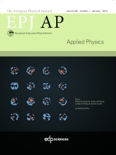
EUROPEAN PHYSICAL JOURNAL-APPLIED PHYSICS
Connecting Researchers to Pioneering DiscoveriesEUROPEAN PHYSICAL JOURNAL-APPLIED PHYSICS, published by EDP SCIENCES S A in France, serves as a vital platform for the dissemination of cutting-edge research in the fields of condensed matter physics, electronic, optical and magnetic materials, and instrumentation. With an ISSN of 1286-0042 and E-ISSN of 1286-0050, this journal has been a valuable resource for researchers since its inception in 1998, aiming to foster innovation and dialogue among professionals and academics alike. Featuring an impact factor that reflects its growing influence, the journal is currently ranked in the Q4 quartile for several related categories in 2023, underscoring its ongoing contributions to the scientific community despite its relatively competitive positioning. Access to the journal is available through various Open Access options, ensuring that pioneering research is readily accessible to all. As it continues to evolve towards its 2024 objectives, EUROPEAN PHYSICAL JOURNAL-APPLIED PHYSICS remains dedicated to advancing knowledge and facilitating collaboration in applied physics, making it an essential resource for students, researchers, and professionals dedicated to exploring the forefront of physical sciences.
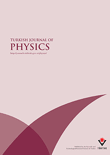
Turkish Journal of Physics
Shaping the future of physics through knowledge sharing.Turkish Journal of Physics, established in 1994 and published by the Tubitak Scientific & Technological Research Council Turkey, is a prominent platform for the dissemination of innovative research in the field of physics and related areas. With an ISSN of 1300-0101 and an E-ISSN of 1303-6122, this journal has carved a niche in the academic community, evidenced by its ranking within the Q3 category in the 2023 evaluation of Physics and Astronomy. As it converges its published works toward the year 2024, researchers and scholars are encouraged to engage with its rich repertoire of studies that covers general physics and astronomy, currently holding a Scopus rank of #96 out of 243, placing it in the top 60th percentile. The Turkish Journal of Physics serves as a vital resource for advancing knowledge, fostering collaborative research, and providing insights into contemporary advancements in the discipline. While it operates under a subscription model, the quality and impact of its peer-reviewed articles make it an essential read for professionals and students alike, looking to stay informed on critical developments within the physics community.
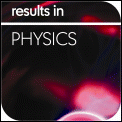
Results in Physics
Innovative Insights for Tomorrow's PhysicsResults in Physics, an esteemed open-access journal published by ELSEVIER, has been a prominent platform for disseminating cutting-edge research in the field of physics since its establishment in 2011. With its ISSN 2211-3797 and E-ISSN 2211-3797, this journal proudly holds a Q2 ranking in the Physics and Astronomy category for 2023, showcasing its significance and quality within the scientific community. With a remarkable Scopus rank of #28 out of 243 in the general physics and astronomy domain, placing it within the 88th percentile, Results in Physics serves as a vital resource for researchers, professionals, and students alike, fostering a collaborative environment for the advancement of knowledge across various subfields. The journal aims to provide a rapid and unrestricted access to innovative findings, encouraging open scientific dialogue and enhancing the visibility of breakthrough research. Located in the Netherlands at RADARWEG 29, 1043 NX AMSTERDAM, Results in Physics continues to uphold its commitment to excellence and accessibility in the ever-evolving landscape of physics research.
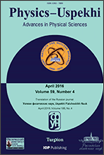
PHYSICS-USPEKHI
Fostering Collaboration in the Heart of PhysicsPHYSICS-USPEKHI, published by Uspekhi Fizicheskikh Nauk, is a prominent peer-reviewed journal in the field of physics and astronomy, reaching researchers and professionals since its inception in 1993. With an ISSN of 1063-7869 and an E-ISSN of 1468-4780, this esteemed journal has been classified as Q2 in the Physics and Astronomy category based on the 2023 quartiles, ranking 74 out of 243 journals in its Scopus classification, placing it in the 69th percentile. Although currently not an open access journal, it provides invaluable insights and advancements in the field, fostering an environment for scholarly exchange and collaborative research. Based in Moscow, Russia, PHYSICS-USPEKHI continues to shape the landscape of theoretical and experimental physics, inviting submissions that contribute to its rich legacy of high-impact scientific discourse.

INDIAN JOURNAL OF PHYSICS
Fostering Knowledge Exchange in the World of PhysicsINDIAN JOURNAL OF PHYSICS, published by the Indian Association for Cultivation of Science, serves as a pivotal platform for researchers and scholars in the field of physics and astronomy. With its ISSN 0973-1458 and E-ISSN 0974-9845, this journal is committed to presenting innovative research and developments across diverse topics in physics, covering both theoretical and experimental studies. The journal has made its mark in the academic community, evidenced by its classification in the Q3 category within the Physics and Astronomy domain as of 2023, and ranks #100 out of 243 in the Scopus curated database, placing it in the 59th percentile. Spanning from 2005 to 2024, the INDIAN JOURNAL OF PHYSICS aims to foster knowledge exchange and stimulate discussions among physicists and scientific enthusiasts. Whether you are a researcher looking to publish your findings, a professional seeking updates in your field, or a student eager to explore varying aspects of physics, this journal is an invaluable resource contributing significantly to the understanding and advancement of physics in India and beyond.

Recent Contributions to Physics
Advancing knowledge in the world of physics.Recent Contributions to Physics is a distinguished journal published by AL-FARABI KAZAKH NATIONAL UNIVERSITY, focusing on the latest developments and research breakthroughs in the field of physics. Established as an open access journal since 2008, it aims to facilitate the wide dissemination of knowledge by allowing researchers, professionals, and students worldwide to access high-quality content without barrier. Featuring a diverse range of topics within physics, from theoretical innovations to practical applications, this journal is an essential resource for anyone seeking to stay at the forefront of scientific advancement. Its commitment to quality and accessibility not only enhances the impact of research in the scientific community but also promotes collaboration across disciplines. With its dedication to fostering a vibrant academic dialogue, Recent Contributions to Physics is poised as a key contributor to the future of physics research.

DOKLADY PHYSICS
Shaping the Future of Physics Research and Application.DOKLADY PHYSICS is a prominent academic journal dedicated to advancing knowledge in the fields of computational mechanics, mechanics of materials, and general physics and astronomy. Published by MAIK NAUKA/INTERPERIODICA/SPRINGER, this journal has established itself as a crucial resource for researchers and professionals keen on exploring the intricacies of physical phenomena and engineering applications. With its ISSN 1028-3358 and E-ISSN 1562-6903, DOKLADY PHYSICS has been contributing to scientific discourse since its inception in 1996 and continues to provide a platform for innovative research up to 2023. Despite its current Q3 ranking in several key categories, the journal maintains an inclusive approach, striving to influence both academic and practical aspects of its fields. While the journal may not be open access, it remains a vital publication for those interested in high-quality research, as reflected in its Scopus ranking positions across various engineering and physics categories.

PHYSICA SCRIPTA
Fostering Collaboration for a Brighter Scientific FuturePHYSICA SCRIPTA, established in 1970 and published by IOP Publishing Ltd, is a prestigious journal dedicated to the broad fields of physics, encompassing topics such as atomic and molecular physics, condensed matter physics, and mathematical physics. With an impressive commitment to advancing scientific knowledge, it holds a significant standing in the academic community, evidenced by its Q2 and Q3 rankings across various categories in 2023. The journal is instrumental for researchers, professionals, and students seeking to disseminate and engage with high-quality research, fostering collaboration and innovation within the field. Although it currently does not offer open access options, its robust editorial standards ensure the dissemination of impactful studies, contributing to its rising citation metrics. Published from the United Kingdom, PHYSICA SCRIPTA continues to be a vital resource for contemporary developments in physics, paving the way for future discoveries.

Jurnal Fizik Malaysia
Exploring New Frontiers in the Realm of Physics.Jurnal Fizik Malaysia is a prominent academic journal dedicated to advancing the field of physics, published by the esteemed Institut Fizik Malaysia. With an aim to foster knowledge dissemination and research collaboration among physicists, the journal serves as a vital platform for original research articles, reviews, and technical notes that cover various sub-disciplines of physics. Although the journal operates under a traditional subscription model, its commitment to quality has been bolstered by a rigorous peer-review process, ensuring high academic standards. Researchers and students in Malaysia and beyond are encouraged to engage with this journal, contributing to a deeper understanding of physical sciences and its applications. Moreover, with its ISSN 0128-0333, Jurnal Fizik Malaysia continues to play a significant role in the scientific community, enhancing visibility and accessibility for local and international research outputs in the ever-evolving landscape of physics.

REVISTA MEXICANA DE FISICA
Empowering Scientific Discourse in Physics and AstronomyREVISTA MEXICANA DE FISICA is a prominent academic journal dedicated to advancing knowledge in the fields of Physics and Education. Published by the SOC MEXICANA FISICA, this journal plays a pivotal role in disseminating innovative research and educational methodologies from Mexico and beyond. With a publication history that spans from 1991 to 2024, it has established itself as an essential resource for researchers, professionals, and students who seek to deepen their understanding of general physics and astronomy. The journal is classified in the Q3 quartile in both education and physics & astronomy, showcasing its quality and relevance within the academic landscape. While the journal currently operates on a subscription basis, it provides a valuable platform for emerging voices and established scholars alike. By fostering a collaborative environment for scientific discourse, REVISTA MEXICANA DE FISICA continues to be an important channel for the ongoing evolution of scientific education and exploration in the physical sciences.